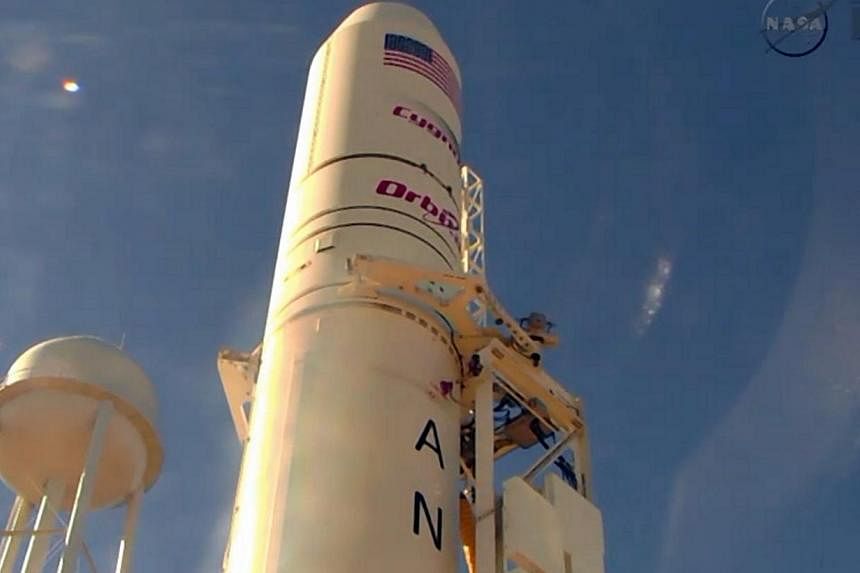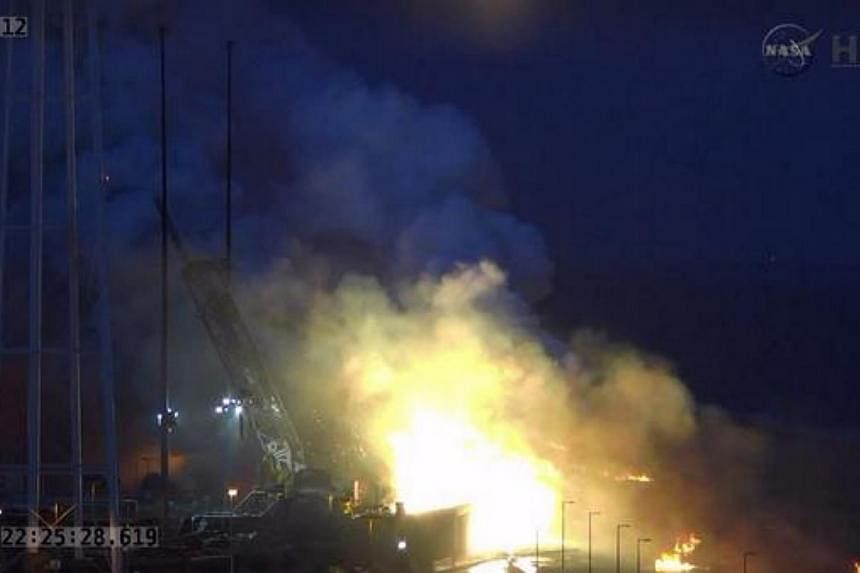(REUTERS) - An unmanned Antares rocket exploded seconds after lift off from a commercial launch pad in Virginia on Tuesday, a Nasa TV broadcast showed.
The 14-story rocket, built and launched by Orbital Sciences Corp, bolted off its seaside launch pad at the Wallops Flight Facility at 6.22pm EDT/2222 GMT (6.22am Singapore time) carrying a Cygnus cargo ship for the International Space Station.
It exploded seconds later. The cause of the accident was not immediately available, said Nasa mission commentator Dan Huot.

Nasa said there were no injuries. "This has been a lot of hard work to get to this point," Orbital Sciences Executive Vice-President Frank Culbertson told the launch team just before liftoff.
The six crew members in orbit aboard the space station - two NASA astronauts, one from the European Space Agency and three Russian cosmonauts - watched the launch via a NASA TV feed, said Mr Mike Suffredini, the space station programme manager. "They were disappointed ... of course they are well aware that they have plenty of resources on orbit," Mr Suffredini told reporters during a conference call.
With a Russian cargo ship due to reach the space station on Wednesday, just 14 hours after the explosion in Virginia, the loss of the Cygnus vessel posed no immediate problem for the orbiting team. "There was no cargo that was absolutely critical" aboard Cygnus, NASA Associate Administrator William Gerstenmaier said. Suffredini added that the crew has enough food and other supplies aboard to last four to six months.
The cause of the mishap was under investigation, said Mr Culbertson.
Footage of Tuesday's launch showed the Antares rising slowly into the night sky as flames suddenly engulfed the rocket, from the bottom to the top about 11 seconds after liftoff, before the vehicle sank back downward in a conflagration.
Ms Ronda Miller, manager of the Ocean Deli in Wallops Island, Virginia, told Reuters she felt the force of the blast from the eatery, about 8km from the launch pad.
"We were standing outside waiting for it to launch and we saw bright red, and then we saw a big black cloud, and it shook the whole building where we work," Ms Miller said. "And then I came back in to work and seen fire trucks going every which way."
NASA said no one was in the vicinity of the explosion, and Orbital Sciences said in a statement: "We've confirmed that all personnel have been accounted for. We have no injuries in the operation today." The spacecraft was carrying "some classified cryptographic equipment, so we do need to maintain the area around the debris in a secure manner," said Mr Mike Pinkston, the company's Antares programme manager.
The National Security Agency had no immediate comment on the classified equipment reported to be aboard the cargo ship.
NASA officials said damage on the ground appeared limited to the Virginia-owned launch facility, but its full extent was not immediately known. The rocket itself and the cargo ship it carried were valued at US$200 million, Mr Culbertson said. "This is the only pad that's certified for launching the Antares rocket, so repairing it will be one of our high priorities," he told reporters in a conference call. "We will not fly until we understand the root cause and the corrective action to make sure this doesn't happen again." The Antares rocket has been launched successfully on four previous missions.
Tuesday's launch had been delayed one day after a boat sailed into a restricted safety zone beneath the rocket's intended flight path.
Virginia-based Orbital Sciences is one of two companies hired by Nasa to fly cargo to the station after the space shuttles were retired. Tuesday's planned flight was to be the third of eight under the company's US$1.9 billion (S$2.4 billion) contract with Nasa.
The second US supply line to the station is run by privately owned Space Exploration Technologies, or SpaceX, which is preparing for its fourth flight under a separate, US$1.6 billion Nasa contract.
Outfitted with a new, more powerful upper-stage engine, the Antares rocket launched on Tuesday carried a Cygnus spacecraft packed with 2,293kg of supplies, science experiments and equipment, a 15 per cent increase over previous missions.
Cygnus was to loiter in orbit until Nov 2, then fly itself to the station so astronauts can use a robotic crane to snare the capsule and attach it to a berthing port. The station, a US$100 billion research laboratory owned and operated by 15 nations, flies about 418km above Earth. In addition to food, supplies and equipment, the Cygnus spacecraft was loaded with more than 725kg of science experiments, including an investigation to chemically analyse meteors as they burn up in Earth's atmosphere.
The Cygnus capsule was the first of two cargo ships scheduled to head to the space station this week. Russia was preparing to launch a Soyuz rocket and Progress freighter from the Baikonur Cosmodrome in Kazakhstan on Wednesday morning.
Orbital Sciences is in the midst of merging with Alliant Techsystem Inc's Aerospace and Defence division, a deal that analysts expect to close sometime early next year. The company is competing for a number of NASA missions or projects that will help fuel revenue over coming years.
The Cygnus also carried a prototype satellite owned by Redmond, Washington-based startup Planetary Resources, which is developing technology to mine asteroids. The satellite, designated A3, was to be released into space by a commercially owned small spacecraft launcher aboard the station.
Orbital Sciences stock fell 15.5 per cent to a two-month low of US$25.65 in after-hours trading.



